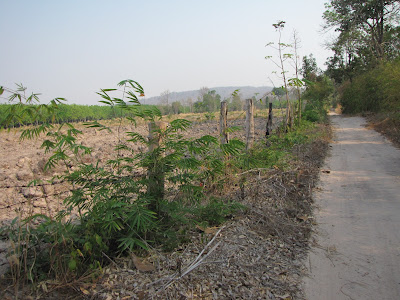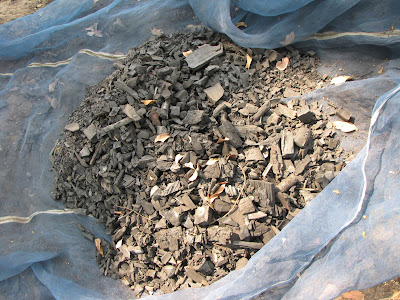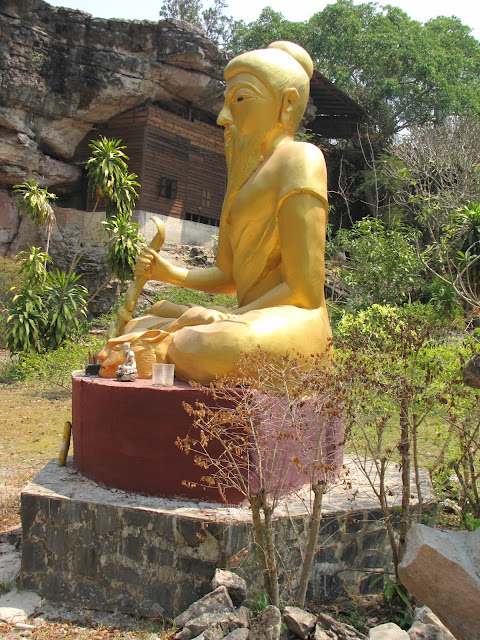Recently we learned that there is additional scouting activity at this time of year - focused on the rest of the students who didn't get to attend the Scout Camp this year: on Friday, March 1st, the 5th graders and the 7th and 8th graders went on a long hike in the countryside near the school. The temperature reached 101 degrees F. that day, so Mary passed (and stayed at school to teach some classes), but George went. Since this story is narrated only by George, he'll switch to the first person to make it simpler.
I was asked whether I wanted to walk with the students or go with the teachers. Not knowing what was in store, I said, go with the students, but was quickly advised by a teacher to go with them. So I did. It turned out that it was a pretty long hike and the students walked while the teachers rode in air conditioned cars to their stations, where they waited in the shade for the students to come by, made sure they were all OK, and gave them water. I was glad about the decision to go with the teachers!
When teacher and friend Thanorm and I got to Thanorm's station, it was early - well before the students would arrive, so I went for a walk. I walked through a grove of Hevea trees - a natural source of rubber - and past what I assume is a shelter for the farmers during the season for tapping the trees.
The trees aren't tapped until they reach maturity (about 7 years). Tapping them involves cutting the bark, severing latex vessels. Each time the tree is tapped, a channel is prepared along which the latex flows. This method avoids wounding the trees.
We're in the "dry season" and it really is that - we've seen hardly any rain since we arrived in Khemmarat in early November last year. The only significant rain we remember was a heavy shower during the Loi Krathong Festival on November 28th last year and that only lasted an hour or so. The rainy season is supposed to start in late April to early May. The land is very dry now and the trees look stressed, but, to our amazement, plants spring new buds and flowers every week. We assume it will be very green here by August. These pictures should give an idea of what it's like now.
Even the Hevea trees are blooming despite the drought:
I found this and was told it's not edible
and saw a beautiful butterfly:
Cassava is harvested by pulling the roots out of the ground and removing them from the base of the plant. The plant is propagated by cutting the stem into short sections; these are planted prior to the rainy season.

There are many large cisterns around rural Thailand like the one pictured below. They are used to catch and store rainwater. Thanorm told me that, in one of many of a variety of different jobs in his younger years, he sold these -- it took three men to carry one.
Thanorm suggested that I ride with Scout chief Parinwat and visit the other stations. The first station (A3, marked on the tree) was manned by Chandwit and Toon (center and right); that's Parinwat on the left.
The second station (a food shop on the highway) was manned by Giap (computer teacher, left) and his friend Tanagon, a music teacher from another school.
The last station I saw was manned by Baan Nong Phue music teacher and band director Watit. Note the stacks of cassava behind him.
The Scouts got water and then lined up to get their faces smeared with ashes.
Then they were off as a new group arrived.
Thanks to Parinwat, Thanorm, Watit, and the rest of the Scout leaders for a comfortable, interesting, and fun "hike."
Mary and I have seen a number of large, mud-colored mounds with openings in them, around Khemmarat and Baan Nong Phue and wondered what they were. By Watit's station, I saw one up close and learned that they are "ovens" to make charcoal.
If you want to learn more about charcoal making in Thailand (as Mary and I did), here's a link to an informative YouTube video: http://www.youtube.com/watch?v=N6qTf1IdMvY
Next Thanorm and Chandwit took me to Wat Tam Pha Phuang (cave temple).
Unlike the other figures on the temple grounds, the figure below was small -- about a foot tall.
Then Thanorm drove us to his house.
That's teak wood on the right side of the photo, which Thanorm uses for building.
Thanorm's beautiful, young daughter Piyapat was sitting on her aunt's lap on a platform in front of the house with friends.
Before we headed back to school for lunch, we joined up with many of the teachers who had been at various stations on the hike route and I got a chance to talk with them more than I usually do at school.
The teachers had a nice lunch back at school.
And I was able to see the Scouts doing some very fancy food preparation.
Before I left school that day, I noticed that pictures of Mary and me had been added to the board outside the Director's office with photos of all the teachers and staff of the school. That's us near the bottom: Mary's holding flowers and we both have Valentine's Day stickers on our shirts -- part of the Baan Nong Phue family!



















































No comments:
Post a Comment